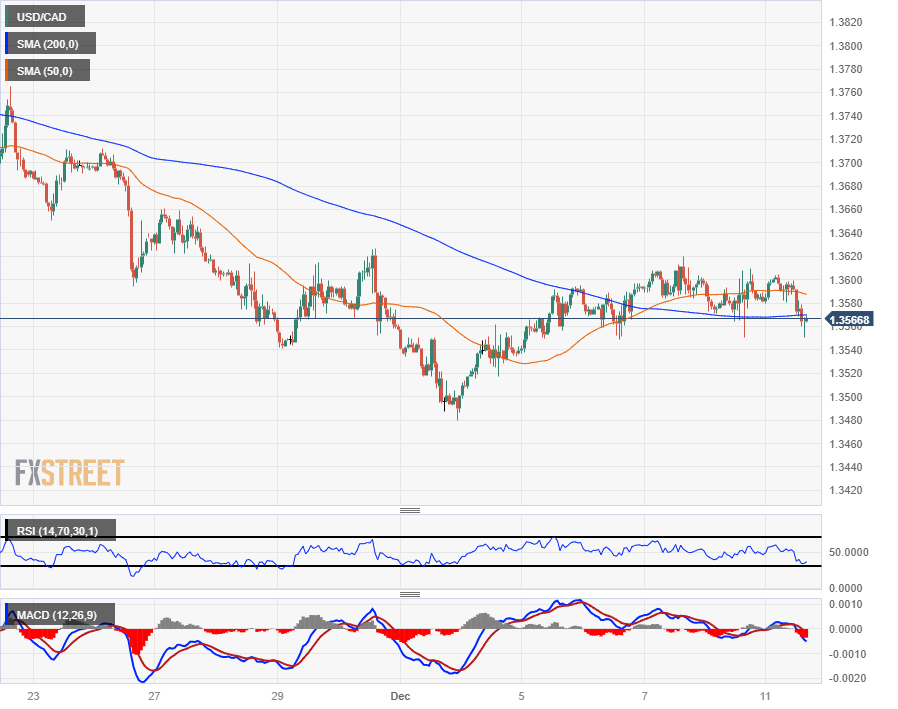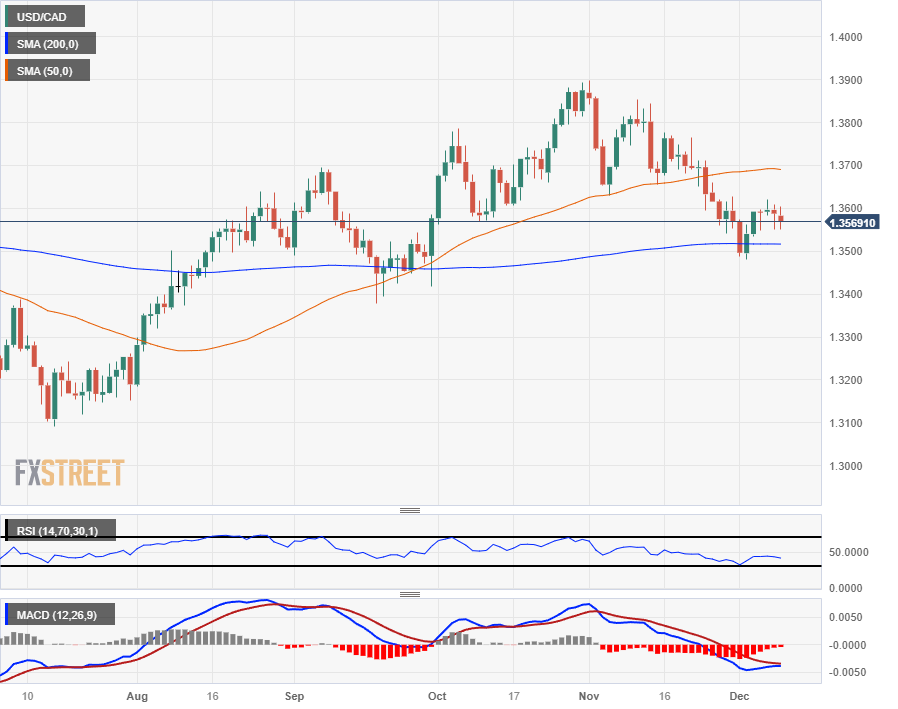Canadian Dollar catches a bid on Monday as markets gear up for heavy central bank week

- Canadian Dollar climbs on Monday, catching a broad-market bid.
- Canada economic data is thin this week, but BoC Gov Macklem will make Friday appearance.
- US CPI inflation, Fed rate call and interest rate outlook to be the week’s linchpin.
The Canadian Dollar (CAD) eased higher on Monday, taking a slim but broad step up against its major currency peers as markets gear up for a hectic week that sees several high-impact central bank showings to round the corner into the end of the trading year.
Canada is largely absent from the economic calendar data docket this week, with only a smattering of low-tier data late Thursday and into Friday. The only event of note will be Bank of Canada (BoC) Governor Tiff Macklem’s appearance, slated for late Friday. BoC Governor Macklem will be giving a speech at the Economic Club of Toronto, with the speech text released fifteen minutes ahead.
The upcoming trading week will see significant focus on central bank action with a US inflation data kicker when US Consumer Price Index (CPI) inflation is released on Tuesday. Wednesday will be of particular note to CAD when the US Federal Reserve (Fed) releases its latest rate call as markets broadly forecast a hold at 5.25% to 5.5%.
The US Federal Open Market Committee (FOMC) will release its updated economic projections alongside its policy statement, and investors will be looking closely at any changes to the FOMC’s forward-looking interest rate projections, known as the “Dot Plot”. The Fed’s Monetary Policy Statement and rate call are slated for 19:00 GMT on Wednesday, with the FOMC Press Conference thirty minutes later at 19:30 GMT.
Daily Digest Market Movers: Canadian Dollar steps higher across the board in thin Monday action
- The Canadian Dollar is in the green to kick off the new trading week, climbing over a full percent against the Japanese Yen (JPY).
- The CAD is hardening gains against the Aussie (AUD) and Kiwi (NZD), up four-tenths and a third of a percent against the Antipodeans, respectively.
- The CAD’s weakest performance on Monday is still on the high side, gaining over a tenth of a percent against the Swiss Franc (CHF) and the Pound Sterling (GBP), with an additional sixth of a percent against the US Dollar (USD) in Monday trading.
- The broader market’s key focus in the early week will be US inflation data with Tuesday’s CPI release.
- Market forecasts call for Core US CPI to climb at the near end of the tail with annualized inflation expected to hold steady.
- Headline MoM US CPI inflation is forecast to tick up from 0.0% to 0.1% for November, with the YoY expected to tick down from 3.2% to 3.1%.
- November’s Core US CPI is forecast to print at 0.3% versus October’s 0.2%, with consumer price growth (less food and energy prices) expected to hold flat at 4% for the year into November, still well above the Fed’s 2% target.
- Market could see positioning shifts on Tuesday as investors glean Fed forecasts from Tuesday’s CPI inflation print.
Canadian Dollar price today
The table below shows the percentage change of Canadian Dollar (CAD) against listed major currencies today. Canadian Dollar was the weakest against the Swiss Franc.
| USD | EUR | GBP | CAD | AUD | JPY | NZD | CHF | |
| USD | 0.17% | 0.00% | -0.11% | 0.28% | 1.00% | 0.10% | -0.01% | |
| EUR | -0.17% | -0.17% | -0.29% | 0.11% | 0.83% | -0.07% | -0.18% | |
| GBP | 0.00% | 0.17% | -0.12% | 0.27% | 0.99% | 0.09% | -0.02% | |
| CAD | 0.14% | 0.29% | 0.11% | 0.38% | 1.14% | 0.21% | 0.10% | |
| AUD | -0.28% | -0.10% | -0.28% | -0.39% | 0.73% | -0.18% | -0.29% | |
| JPY | -0.99% | -0.84% | -1.10% | -1.12% | -0.74% | -0.91% | -1.03% | |
| NZD | -0.10% | 0.08% | -0.10% | -0.21% | 0.18% | 0.90% | -0.11% | |
| CHF | 0.01% | 0.19% | 0.01% | -0.10% | 0.31% | 1.04% | 0.11% |
The heat map shows percentage changes of major currencies against each other. The base currency is picked from the left column, while the quote currency is picked from the top row. For example, if you pick the Euro from the left column and move along the horizontal line to the Japanese Yen, the percentage change displayed in the box will represent EUR (base)/JPY (quote).
Technical Analysis: Canadian Dollar sees thin to moderate gains on Monday, USD/CAD capped by 1.3600
The Canadian Dollar (CAD) is bidding higher on Monday, seeing thin but determined gains against the US Dollar (USD) to keep the USD/CAD pair pinned below the 1.3600 handle.
Intraday action sees some consolidation for the USD/CAD between the 50-hour and 200-hour Simple Moving Averages (SMA) near 1.3585 and 1.3570, respectively. Bids have cycled inside last week’s late range between 1.3620 and 1.3560.
Daily candlesticks have the USD/CAD waffling just north of the 200-day SMA near 1.3515, and price action is set to see some rough chop with the pair caught between the 200-day SMA and the 50-day SMA near 1.3700. Technical resistance firms up at the 1.3600 handle, sandwiching prices between the major price level and the long-term moving average.
USD/CAD Hourly Chart
USD/CAD Daily Chart

Canadian Dollar FAQs
The key factors driving the Canadian Dollar (CAD) are the level of interest rates set by the Bank of Canada (BoC), the price of Oil, Canada’s largest export, the health of its economy, inflation and the Trade Balance, which is the difference between the value of Canada’s exports versus its imports. Other factors include market sentiment – whether investors are taking on more risky assets (risk-on) or seeking safe-havens (risk-off) – with risk-on being CAD-positive. As its largest trading partner, the health of the US economy is also a key factor influencing the Canadian Dollar.
The Bank of Canada (BoC) has a significant influence on the Canadian Dollar by setting the level of interest rates that banks can lend to one another. This influences the level of interest rates for everyone. The main goal of the BoC is to maintain inflation at 1-3% by adjusting interest rates up or down. Relatively higher interest rates tend to be positive for the CAD. The Bank of Canada can also use quantitative easing and tightening to influence credit conditions, with the former CAD-negative and the latter CAD-positive.
The price of Oil is a key factor impacting the value of the Canadian Dollar. Petroleum is Canada’s biggest export, so Oil price tends to have an immediate impact on the CAD value. Generally, if Oil price rises CAD also goes up, as aggregate demand for the currency increases. The opposite is the case if the price of Oil falls. Higher Oil prices also tend to result in a greater likelihood of a positive Trade Balance, which is also supportive of the CAD.
While inflation had always traditionally been thought of as a negative factor for a currency since it lowers the value of money, the opposite has actually been the case in modern times with the relaxation of cross-border capital controls. Higher inflation tends to lead central banks to put up interest rates which attracts more capital inflows from global investors seeking a lucrative place to keep their money. This increases demand for the local currency, which in Canada’s case is the Canadian Dollar.
Macroeconomic data releases gauge the health of the economy and can have an impact on the Canadian Dollar. Indicators such as GDP, Manufacturing and Services PMIs, employment, and consumer sentiment surveys can all influence the direction of the CAD. A strong economy is good for the Canadian Dollar. Not only does it attract more foreign investment but it may encourage the Bank of Canada to put up interest rates, leading to a stronger currency. If economic data is weak, however, the CAD is likely to fall.
